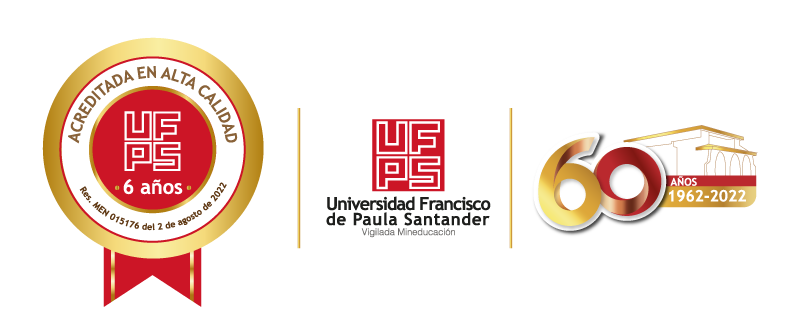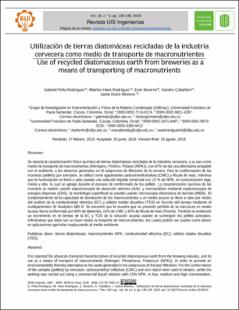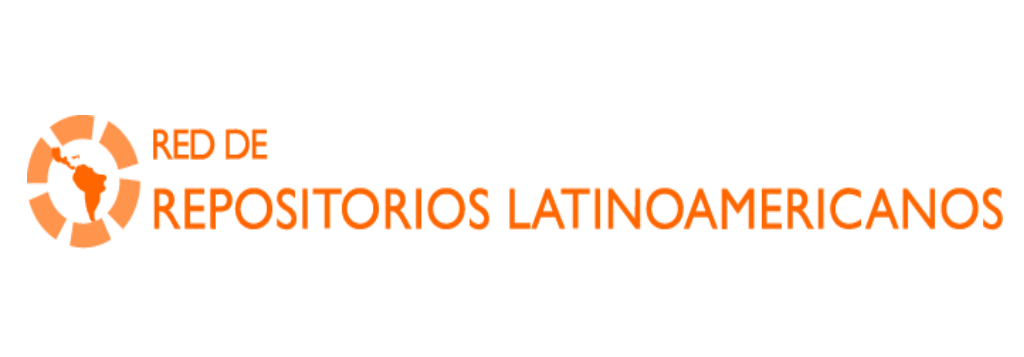Mostrar el registro sencillo del ítem
Use of recycled diatomaceous earth from breweries as a means of transporting of macronutrients
| dc.contributor.author | Peña Rodriguez, Gabriel | |
| dc.contributor.author | Rodriguez Aguilar, Marlon Hans | |
| dc.contributor.author | BECERRA, EVER | |
| dc.contributor.author | Caballero, Xandro | |
| dc.contributor.author | Hector Jaime, Dulce-Moreno | |
| dc.date.accessioned | 2021-11-25T20:10:55Z | |
| dc.date.available | 2021-11-25T20:10:55Z | |
| dc.date.issued | 2019-09-16 | |
| dc.identifier.uri | http://repositorio.ufps.edu.co/handle/ufps/1437 | |
| dc.description.abstract | Se reporta la caracterización físico-química de tierras diatomáceas recicladas de la industria cervecera, y su uso como medio de transporte de macronutrientes (Nitrógeno, Fósforo, Potasio (NPK)), con el fin de dar una alternativa amigable con el ambiente, a los desechos generados en el subproceso de filtración de la cerveza. Para la conformación de las muestras (pellets) por extrusión, se utilizó como aglutinantes carboximetilcelulosa (CMC) y fécula de maíz, mientras que la humectación se llevó a cabo usando una solución líquida comercial con 15 % de NPK, en concentración baja, media y alta, la cual se agregó durante el proceso de conformado de los pellets. La caracterización química de las muestras se realizó usando espectroscopía de absorción atómica (AA), y microanálisis mediante espectroscopia de energías dispersas (EDS), la morfología superficial se estudió usando microscopia electrónica de barrido (MEB). El comportamiento de la capacidad de devolución de los macronutrientes a un medio acuoso se llevó a cabo por medio del análisis de la conductividad eléctrica (EC) y sólidos totales disueltos (TDS) en función del tiempo mediante el multiparámetro SI Analytics 680 K. Se encontró que la muestra que no presentó pérdida de su estructura en medio acuoso fue la conformada por 60% de diatomita, 10% de CMC y 30% de fécula de maíz (%w/w). También se evidenció un incremento en el tiempo de la EC y TDS de la solución acuosa cuando se sumergían los pellets activados, infiriéndose que éstos son un buen medio se trasporte de macronutrientes, los cuales podrán ser usados como abono en aplicaciones agrícolas coadyuvando al medio ambiente | spa |
| dc.description.abstract | It is reported the physical-chemical characterization of recycled diatomaceous earth from the brewing industry, and its use as a means of transport of macronutrients (Nitrogen, Phosphorus, Potassium (NPK)), in order to provide an environmentally friendly alternative to the waste generated in the subprocess of the beer filtration. For the conformation of the samples (pellets) by extrusion, carboxymethyl cellulose (CMC) and corn starch were used to binders, while the wetting was carried out using a commercial liquid solution with 15% NPK, in low, medium and high concentration which was added during the pellet forming process. The chemical characterization of the samples was done using atomic absorption spectroscopy (AA), and microanalysis by dispersed energy spectroscopy (EDS), the surface morphology was studied using scanning electron microscopy (SEM). The behavior of the macronutrient return capacity to an aqueous medium was carried out by means of the analysis of the electrical conductivity (EC) and total dissolved solids (TDS) as a function of time using the SI Analytics 680 K multiparameter. It was found that the sample that did not present loss of its structure in aqueous medium was formed by 60% of diatomite, 10% of CMC and 30% of corn starch (%w/w). Also the increase in the time of the EC and TDS of the aqueous solution when the activated pellets were submerged was observed, inferring that these are a good means of transporting macronutrients, which can be used as fertilizer in agricultural applications contributing to the environment. | eng |
| dc.format.mimetype | application/pdf | spa |
| dc.language.iso | spa | spa |
| dc.publisher | Revista UIS Ingenierías | spa |
| dc.rights | Los autores conservan los derechos de autor y ceden a la revista el derecho de la primera publicación, con el trabajo registrado bajo la Licencia Creative Commons Atribución-NoDerivadas 4.0 Internacional. que permite a terceros utilizar lo publicado siempre que mencionen la autoría del trabajo y a la primera publicación en la Revista UIS Ingenierías | spa |
| dc.source | https://revistas.uis.edu.co/index.php/revistauisingenierias/article/view/9677 | spa |
| dc.title | Use of recycled diatomaceous earth from breweries as a means of transporting of macronutrients | eng |
| dc.type | Artículo de revista | spa |
| dcterms.references | Brown Julie, “Diatomaceous Earth, Renewable Beer Filtration and Secrets of Great Beer,” EP Minerals, 2016. [En línea]. Disponible en: http://blog.epminerals.com/diatomaceous-earth-and-the-secret-to-great-beer. | spa |
| dcterms.references | L. Fillaudeau, P. Blanpain-Avet, and G. Daufin, “Water, wastewater and waste management in brewing industries,” J. Clean. Prod., vol. 14, no. 5, pp. 463–471, 2006. doi: 10.1016/j.jclepro.2005.01.002. | spa |
| dcterms.references | N. Ediz, İ. Bentli, and İ. Tatar, “Improvement in filtration characteristics of diatomite by calcination,” Int. J. Miner. Process., vol. 94, no. 3, pp. 129–134, 2010, doi: 10.1016/j.minpro.2010.02.004. | spa |
| dcterms.references | T. R. dos S. Mathias, V. M. F. Alexandre, M. C. Cammarota, P. P. M. de Mello, and E. F. C. Sérvulo, “Characterization and determination of brewer’s solid wastes composition,” J. Inst. Brew., vol. 121, no. 3, pp. 400–404, Jul. 2015, doi:10.1002/jib.229. | spa |
| dcterms.references | M. Evans, “Learn the 3 Rs: Reduce, Reuse, and Recycle,” The Balance Small Business, 2017. [En línea]. Disponible en: https://www.thebalancesmb.com/the-3-r-s-reduce-reuse-and-recycle-3157809. | spa |
| dcterms.references | M. Iliescu, M. Farago, M. Popa, and M. CRISTEA, “Reuse of residual kieselguhr from beer filtration as a fertiliser,” J. Environ. Prot. Ecol., vol. 10, no. 1, 2009. | spa |
| dcterms.references | FAO, “Agricultura mundial: hacia los años 2015/2030,” 2002. | spa |
| dcterms.references | G. Dessalew, A. Beyene, A. Nebiyu, and M. L. Ruelle, “Use of industrial diatomite wastes from beer production to improve soil fertility and cereal yields,” J. Clean. Prod., vol. 157, pp. 22–29, 2017, doi: 10.1016/j.jclepro.2017.04.116. | spa |
| dcterms.references | W. E. Cotching, “Organic matter in the agricultural soils of Tasmania, Australia – A review,” Geoderma, vol. 312, pp. 170–182, 2018, doi:https://doi.org/10.1016/j.geoderma.2017.10.006. | spa |
| dcterms.references | F. Ramukhwatho, A. Seetal, and H. Pienaar, Water and Wastewater Management in the Malt Brewing Industry, no. Edition 2. Republic of South Africa, 2016. | spa |
| dcterms.references | G. K. Adamu and A. K. Aliyu, “Determination of the Influence of Texture and Organic Matter on Soil Water Holding Capacity in and Around Tomas Irrigation Scheme, Dambatta Local Government Kano State,” Res. J. Environ. earth Sci., vol. 4, no. 12, 2009. | spa |
| dcterms.references | F. Borro Muentes, “Estudio de la eficacia de los aglutinantes en la disolución del metronidazol tabletas 250 mg,” Universidad de Guayaquil. Facultad de Ciencias Químicas, 2001 | spa |
| dcterms.references | L. A. Fonseca, E. Trujillo-castro, and G. Peña-rodríguez, “Tortuosidad y permeabilidad de materiales cerámicos mesoporosos de caolín y diatomita Tortuosity and permeability of mesoporous ceramics of kaolin and diatomite,” Rev. UIS Ing., vol. 18, no. 1, pp. 111–117, 2019, doi:10.18273/revuin.v18n1-2019009. | spa |
| dcterms.references | M. Ibrahim et al., “Avances de Investigación 27,” Agroforestería en las Américas, vol. 45, 2007. | spa |
| dcterms.references | C. Gamarra, M. D. Lezcano, M. V. de Ortíz, M. Galeano, and A. C. Cardús, “Relación carbono-nitrógeno en suelos de sistemas silvopastoriles del Chaco paraguayo,” Rev. Mex. Ciencias For., vol. 9, no. 46, Mar. 2018, doi: 10.29298/rmcf.v9i46.134. | spa |
| dc.identifier.doi | https://doi.org/10.18273/revuin.v18n4-2019013 | |
| dc.publisher.place | Bogota , Colombia | spa |
| dc.relation.citationedition | Vol.18 No.4.(2019) | spa |
| dc.relation.citationendpage | 146 | spa |
| dc.relation.citationissue | 4 (2019) | spa |
| dc.relation.citationstartpage | 139 | spa |
| dc.relation.citationvolume | 18 | spa |
| dc.relation.cites | Peña-Rodríguez, G., Rodríguez, M., Becerra, E. A., Caballero, X. M., & Dulce Moreno, H. J. (2019). Utilización de tierras diatomáceas recicladas de la industria cervecera como medio de transporte de macronutrientes. Revista UIS Ingenierías, 18(4), 139–146. https://doi.org/10.18273/revuin.v18n4-2019013 | |
| dc.relation.cites | Revista UIS Ingenierías | |
| dc.relation.ispartofjournal | Revista UIS Ingenierías | spa |
| dc.rights.accessrights | info:eu-repo/semantics/openAccess | spa |
| dc.rights.creativecommons | Atribución-SinDerivadas 4.0 Internacional (CC BY-ND 4.0) | spa |
| dc.subject.proposal | tierras diatomáceas | spa |
| dc.subject.proposal | macronutrientes NPK | spa |
| dc.subject.proposal | conductividad eléctrica (EC) | spa |
| dc.subject.proposal | sólidos totales disueltos (TDS) | spa |
| dc.subject.proposal | diatomaceous earth | eng |
| dc.subject.proposal | macronutrients NPK | eng |
| dc.subject.proposal | Electrical conductivity (EC) | eng |
| dc.subject.proposal | total dissolved solids (TDS) | eng |
| dc.title.translated | Utilización de tierras diatomáceas recicladas de la industria cervecera como medio de transporte de macronutrientes | |
| dc.type.coar | http://purl.org/coar/resource_type/c_6501 | spa |
| dc.type.content | Text | spa |
| dc.type.driver | info:eu-repo/semantics/article | spa |
| dc.type.redcol | http://purl.org/redcol/resource_type/ART | spa |
| oaire.accessrights | http://purl.org/coar/access_right/c_abf2 | spa |
| oaire.version | http://purl.org/coar/version/c_970fb48d4fbd8a85 | spa |
| dc.type.version | info:eu-repo/semantics/publishedVersion | spa |










